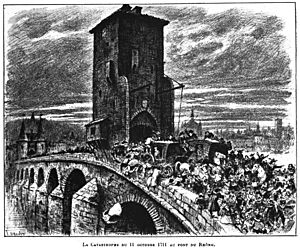Crowd collapses and crushes facts for kids
Crowd collapses and crushes are catastrophic incidents that can occur when a body of people becomes dangerously overcrowded. When a body of people reaches or exceeds the density of four to five people per square meter (about 2.5 square feet per person (1.58’ by 1.58’)), the pressure on each individual can cause the crowd to collapse in on itself, or become so densely packed that individuals are crushed and asphyxiated.
At this density, a crowd can start to act like fluid, sweeping individuals around without their volition. Such incidents are invariably the product of failures of organizations, and most major crowd disasters can be prevented by simple crowd management strategies. Such incidents can occur at large gatherings such as sporting, commercial, social, and religious events. The critical factor is crowd density rather than crowd size.
Prevention
It is believed that most major crowd disasters can be prevented by simple crowd management strategies. Crushes can be prevented by organization and traffic control, such as barriers. On the other hand, barriers in some cases may funnel the crowd toward an already-packed area, such as in the Hillsborough disaster. Hence barriers can be a solution in preventing or a key factor in causing a crush. One problem is lack of feedback from people being crushed to the crowd pressing behind—feedback can instead be provided by police, organizers, or other observers, particularly raised observers, such as on platforms or horseback, who can survey the crowd and use loudspeakers to communicate and direct a crowd. In some cases it may be possible to take simple measures such as spreading movements out over time.
A factor that may contribute to a crush is inexperienced security officers who assume that people's behaviour in a dense crowd is voluntary and dangerous, and start applying force or preventing people from moving in certain directions. In the 1989 Hillsborough disaster, some police and stewards were so concerned with what they saw as possible hooliganism that they took actions that actually made matters worse.
There is risk of a crush when crowd density exceeds about four people per square meter. For a person in a crowd a signal of danger, and a warning to get out of the crowd if possible, is the sensation of being touched on all four sides. A later, more serious, warning is when one feels shock waves travelling through the crowd, due to people at the back pushing forward against people at the front with nowhere to go. Keith Still of the Fire Safety Engineering Group, University of Greenwich, said "Be aware of your surroundings. Look ahead. Listen to the crowd noise. If you start finding yourself in a crowd surge, wait for the surge to come, go with it, and move sideways. Keep moving with it and sideways, with it and sideways." Other recommendations include trying to remain upright, and keeping away from walls and other obstructions if possible.
After the 1883 crush known as the Victoria Hall disaster in Sunderland, England which killed 183 children, a law was passed in England which required all public entertainment venues to be equipped with doors that open outwards—for example, using crash bar latches that open when pushed. Crash bars are required by various building codes.
See also
 In Spanish: Estampida humana para niños
In Spanish: Estampida humana para niños


